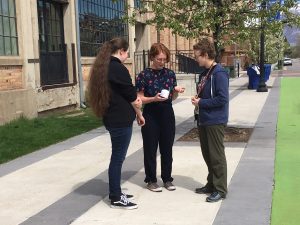Students test ozone levels where cars idle at schools
Apr 18, 2018, 6:29 PM | Updated: 9:51 pm
OGDEN, Utah – The Beehive State’s winter pollution has improved, while our summer pollution has gotten worse in recent years. That’s according to a new air quality report from the American Lung Association.
The 2018 “State of the Air” report ranked Salt Lake City the 18th most-polluted city in the nation for ozone, the pollution that fouls our communities in the summer.
The report from the American Lung Association showed ozone levels have risen to unhealthy levels on the Wasatch Front, putting people at risk for premature death and other serious health effects such as asthma attacks and greater difficulty breathing for those living with a lung disease like COPD.
Officials with the American Lung Association said we need to do more to save lives.
“Across the nation, the report found continued improvement in air quality, but still, more than 4 in 10 Americans – 133.9 million – live in counties that have unhealthful levels of either ozone or particle pollution, where their health is at risk,” said JoAnna Strother, regional director of public policy of the Lung Association in Utah.
 KSL met some students in Ogden taking action on pollution at their school.
KSL met some students in Ogden taking action on pollution at their school.
“I think we definitely need to do better,” said Rachel Love, a 10th grader at the DaVinci Academy in Ogden. “I think we need to go beyond making it an idle-free city.”
Rachel and her classmates said spikes in pollution were tough on students with asthma and other breathing problems.
“That’s really hard on students who want to go play sports, go on hikes, and they can’t on red air days,” she said. “It really sucks.”
“It’s causing a lot of breathing problems for people my age, and people younger,” said Grace Johnston, also a 10th grader at DaVinci Academy.
So, they’re installing two PurpleAir air quality sensors to collect real time data on air quality in the front of the school on Grant Avenue, and a couple of blocks away at their elementary school playground.
“To get more data specifically around our school,” Rachel said. “They’re probably going to read pretty high because we have a lot of traffic, and a lot of CO2 coming out of the cars because of the traffic.”
The students planned to mount one of the monitors right where parents pick up students after school, in what is supposed to be an idle-free zone.
“It is a huge issue,” said Rachel. “Parents will idle for maybe 20 minutes at a time, that’s a lot of CO2 going into the air. We are an idle-free campus, but people just kind of ignore it.”
“If parents are idling, then we can figure out exactly how fast it affects the area, right here,” said Grace.
After collecting data, they planned to petition Ogden City to become an idle-free city.
That tailpipe pollution has been the biggest culprit in our particulate pollution, intensified by inversions in the winter, and our summer ozone, according to the Utah Division of Air Quality.
Ozone is the byproduct of heat cooking up volatile organic compounds on a hot summer day.
“It tends to rise during the high point of the day, and it tends to be invisible so people don’t pay attention to it as much as they do when they see the winter inversions,” said Donna Spangler, a spokesperson for the Utah Department of Environmental Quality.
Utah’s summer pollution, the ozone, doesn’t linger for days as we see with the particulate matter pollution that is trapped by our winter inversions. Ozone intensifies with the heating of the day, and diminishes with cooling at night.
“It’s less noticeable pollution,” said Spangler. “So, I think people are just less willing to take action.”
Many Utahns have already been voluntarily driving less and reducing emissions elsewhere in their lives. In recent years, the Division of Air Quality has enacted 30 new rules to reduce emissions from “area sources.”
Spangler pointed out another reason Utah’s ozone levels now reach unhealthy levels more often. In late 2015, the Environmental Protection Agency lowered the federal health standard for ozone from 75 ppb to 70 ppb.
“We knew at that time that it was going to be a struggle for most of the Wasatch Front communities to meet that standard,” she said. “We’re still struggling.”
The DEQ and the American Lung Association also cited a trend in hotter temperatures for contributing to higher ozone levels.
Spangler said driving smarter and idling less would improve the air we breathe year round.
“Utah enjoys great air quality most of the year,” said Spangler. “But, our short term spikes in pollution can be bad for our health. She said the Utah Department of Environmental Quality’s top priority was to find solutions to combating pollution through research, education, and work with other partners.
The students at DaVinci Academy agree.
“I think we need to do everything we can, because this is our air and we have to breathe it,” said Rachel. “It’s not going away. It’s not getting better.”













